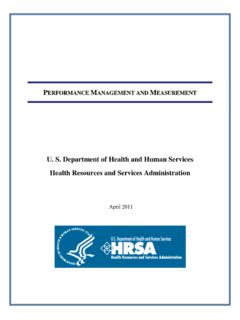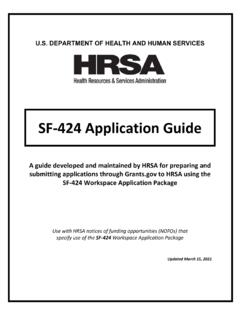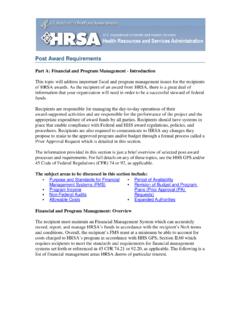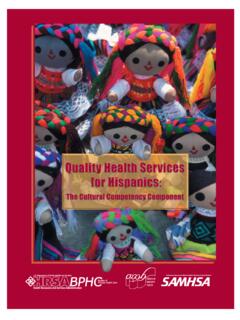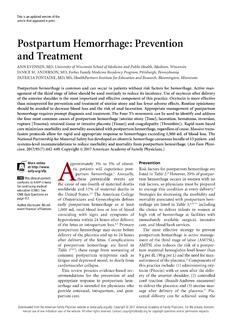Transcription of Strategies for Improving Maternal Health
1 Centers for Disease Control and PreventionNational Center for Chronic Disease Prevention and Health PromotionDivision of Reproductive HealthStrategies for Improving Maternal HealthCharlan D. Kroelinger, PhDChief, Maternal and Infant Health Branch, Division of Reproductive Health , CDCS ecretary s Advisory Committee on Infant MortalityDecember 4, 2019 AGENDA The relationship between Maternal and infant outcomes Data on Pregnancy-Related Deaths Efforts to strengthen surveillance through assessment and quality improvement Summary THE RELATIONSHIP BETWEEN Maternal AND INFANT OUTCOMESMATERNAL Health IS A KEY DRIVER OF INFANT HEALTHM aternal conditions, behaviors, and environments contribute to infant Health and mortality, including pre-term births. Hypertensive disorder / cardiovascular disease Diabetes Obesity Tobacco Substance Use Access to fruits and vegetables Environment/Social Determinants of Health Access to quality care and servicesSources: CDC Division of Reproductive Health ; Gestational Diabetes.
2 Centers for Disease Control and Prevention. July 25 2017. Retrieved from causes of infant mortality, affected by Maternal Health . Birth defects/congenital malformations Disorders related to short gestation and low birthweight Newborn affected by Maternal complications of pregnancy Sudden Infant Death syndrome Newborn injuries Maternal Morbidities Drive Maternal Outcomes: Maternal MortalityTOO MANY MOTHERS DIE700 700 women die each year in from pregnancy-related causes Includes during pregnancy, labor/delivery, or up to a year after the end of pregnancy66% About 66% of these deaths may be preventable2-3X American Indian/ Alaskan Native 2 times more likely to die than white women Black women 3 times more likely to die than white womenPREGNANCY-RELATED MORTALITY IS NOT IMPROVING5791113151719199920002001200220 0320042005200620072008200920102011201220 13201420152016 Deaths per 100,000 : Pregnancy Mortality Surveillance System (PMSS).
3 OF PREGNANCY-RELATED DEATHS OCCUR OUTSIDE THEDELIVERY HOSPITALIZATION, AND THE LEADING CAUSES OF DEATH VARY During pregnancy: cardiovascular conditions At delivery:severe bleeding and amniotic fluid embolism In the week after delivery:severe bleeding and hypertensive disorders of pregnancy 1 week to 42 days after delivery:infection 43 days to 1 year after delivery: cardiomyopathy33%1 week to 1 year after delivery31%During pregnancy36%During delivery and up to 1 week afterwardSource: Petersen EE, et al. Vital Signs: Pregnancy-Related Deaths, United States, 2011 2015 . MMWR Morb Mortal WklyRep 2019;68:423 OF PREGNANCY-RELATED DEATHS CHANGED BETWEEN 1987 AND 2013 Source: Pregnancy Mortality Surveillance SystemRISK INCREASES DIFFERENTLY WITH AGES ource: Petersen EE, et al. Racial/Ethnic Disparities in Pregnancy-Related Deaths United States, 2007 2016. MMWR MorbMortal WklyRep 2019;68:762 IN Maternal MORTALITY BY RACE AND EDUCATION REGARDLESS OF A STATE S OVERALL RATIO THERE IS A NEED TO ADDRESS DISPARITIESPRMR: Pregnancy-related mortality ratioSource: Petersen EE, et al.
4 Racial/Ethnic Disparities in Pregnancy-Related Deaths United States, 2007 2016. MMWR Morb Mortal WklyRep 2019;68:762 MORTALITY IS THE TIP OF THE ICEBERGD eathsNear MissesSevere Maternal Morbidity Maternal Morbidity Requiring HospitalizationMaternal Morbidity Resulting in Emergency Department VisitMaternal Morbidity Resulting in Primary Care Visit Needto start somewhere Impacts on severe Maternal morbidityLEADING CAUSES OF DEATH ARE LINKED TO SEVERE MORBIDITIES Severe Maternal morbidity includes unexpected outcomes of labor and delivery that result in significant short- and long-term consequences to a women s Health Severe Maternal morbidity is increasing Maternal age Pre-pregnancy obesity Pre-existing chronic medical conditions Increased medical costs and hospital staysSEVERE Maternal MORBIDITY INDICATORSI ncreased Acute myocardial infarction or aneurysm Acute renal failure Adult respiratory distress syndrome Cardiac arrest, fibrillation.
5 Or conversion of cardiac rhythm Shock Ventilation/temporary tracheostomy Sepsis Hysterectomy Blood transfusionsSame or Decreased Disseminated intravascular coagulation Air and thrombotic embolism Amniotic fluid embolism Acute congestive heart failure or pulmonary edema Puerperal cerebrovascular disorders Heart failure or arrest during surgery or procedure Eclampsia Severe anesthesia complicationsIndicators calculated using ICD-9 codes from the Nationwide Inpatient Sample of the Healthcare Cost and Utilization Project WHAT IS CDC DOING TO HELP PREVENT Maternal DEATHS AND COMPLICATIONS OF PREGNANCY? Improving THEDATA: REVIEWING Maternal DEATHS Maternal Mortality Review Committees (MMRCs) Review deaths within one year of pregnancy Gather data from multiple sources to provide a deeper understanding Multidisciplinary review of deathsbehavioral healthINSIGHT FROM OTHER MORTALITY REVIEW SYSTEMS IMPACTED MMRC DATA PLATFORM DEVELOPMENT Fetal and Infant Mortality Review Community Action Teams Maternal Mortality Review Information Application (MMRIA)
6 Is being used to standardize recommendations from MMRCs MMRIA Designed in partnership with the CDC Foundation Walks a committee through the review process Gathers the documentation, data, and committee decisions Consistent definitions and process allows CDC to bring together data across jurisdictions for a comprehensive picture of the problemSYSTEMATIC DATA COLLECTION AND USE THROUGHMMRIA, A COMMON LANGUAGE FOR MMRCSMMRIA offers platform for comparable data, enables multi-state reporting for national and regional action CDC provides ongoing training for abstractors, analysts, and committees to use the system Currently finishing the transition to a centrally hosted, CDC systemIMPROVING THEDATA: REVIEWING Maternal DEATHSLEADING CAUSE OF PREGNANCY-RELATED DEATHS VARY BY RACE/ETHNICITYIMPROVING THEDATA: REVIEWING Maternal DEATHSC ommunityFacilitySystems of CareProviderPatient/FamilyInappropriate or delayed treatmentInadequate receipt of careLimited experience with OB emergenciesNonadherenceto medical regimens or adviceUnstable HousingPrioritize pregnant and postpartum women for temporary housing programsImplement obstetric emergency simulation training for emergency department and OB staff membersDevelop policies to ensure pregnant women are transported to a hospital with an appropriate level of Maternal careImplement a Maternal early warning system Expand access to patient navigators, case managers, and peer supportOn average 3 - 4 contributing factors identified for each deathENHANCING REVIEWS ANDSURVEILLANCE TOELIMINATE Maternal MORTALITYS tate is partnering with an awardeeERASE MM awardeePERINATAL QUALITY COLLABORATIVES (PQCS)
7 State or multi-state networks of multidisciplinary teams that are working to improve measurable outcomes for Maternal and infant Health by Advancing evidence-informed clinical practices and processes using quality improvement (QI) principles. Addressing gaps by working with clinical teams, experts and stakeholders, including patients and families Spreading best practices Reducing variation Optimizing resources to improve perinatal care and outcomes KEY PQC Strategies Collaborative learning model Rapid-response data for quality improvement QI science support and assistanceto clinical teams Ultimate goal = improvements in population-level outcomes in Maternal and infant healthSTATUS OF PQCsIN THE UNITED STATESPQC INITIATIVES Obstetric/ Maternal Reduction of non-medically indicateddeliveries <39 weeks gestation Progesterone for prevention of preterm birth Improve response to and management of oobstetric hemorrhageohypertensive disorders of pregnancy Maternal substance abuse Reduction of unnecessary cesarean deliveries Neonatal Safe Sleep Neonatal Abstinence Syndrome Healthcare-associated infections in newborns Breastfeeding/Human Milk in NICUsREDUCING Maternal MORBIDITY FROM OBSTETRIC HEMORRHAGECALIFORNIA
8 Maternal QUALITY CARE COLLABORATIVE A statewide initiative to implement Maternal safety bundles to reduce severe Maternal morbidity from obstetric hemorrhage Implementation of the hemorrhage Maternal safety bundle was scaled to a large number of hospitals (99 hospitals with 256,541 births) Severe Maternal morbidity was reduced by among hemorrhage patients Severe Maternal morbidity was reduced by among all women giving birthSource: Main et al. Reduction of severe Maternal morbidity from hemorrhage . Am J PERINATAL QUALITY COLLABORATIVEMATERNAL HYPERTENSION INITIATIVE: TIME TO TREATMENT<3030-60 60 Missed Opportunity/No Action TakenSEVERE Maternal MORBIDITY RATE, DELIVERIES WITH HYPERTENSION, BIRTH CERTIFICATE DATA, ALL ILLINOIS HOSPITALSS ource: A Borders, ILPQC Created based on need identified by states working in risk-appropriate care Produces standardized Maternal and neonatal level of care assessments for birth facilities CDC provides results back to state Aligns with guidelines1,2,3published by ACOG/SMFM* and AAP Questions about:oHospital equipment & staffingoSub-specialists & their availability oSelf-designation of careoVolume of proceduresoDrills & protocols for Maternal emergencies oTransports & facility-level statisticsCDCLOCATE1 Committee on Fetus and Newborn (2012).
9 "Levels of Neonatal Care." Pediatrics 130(3): 587. 2 Menard, M. Kathryn, et al. "Levels of Maternal care."American Journal of Obstetrics and (2015): , S. J., et al. (2017). Guidelines for perinatal care, Am AcadPediatrics.* in process of updating to be consistent with 2019 ACOG/SMFM updateCDCLOCATE JURISDICTIONS**as of June 2019>800 facilities 17 jurisdictionsMATERNAL ASSESSMENT DISCREPANCIES*Based on the 2015 ACOG/SMFM guidelinesfor levels of Maternal care, what do you consider your level of Maternal careto be? Self-assessmentLOCAT eassessment< Level I3%13%Level I27%36%Level II32%40%Level III19%8%Level IV6%3%Unknown14%-* Based on data from 767 facilities in 15 jurisdictions Maternal TRANSPORT DATA BY LOCATE LEVELDoes your facility have a formal written plan for transport of complicated obstetric/ Maternal patients? Ye s 83%Does this formal written plan Transport out to higher level of care facilityReceivefrom a lower level of care facility< LevelI73%5%Level I83%18%Level II75%29%Level III67%55%Level IV48%64%REVIEW OF Maternal TRANSPORT AND TELEMEDICINE POLICIES State transport and telemedicine policy status 60% of states have an established state-level policy for Maternal transport 33% of states with a transport policy specify reimbursement for Maternal transport 2 states have telemedicine policy language specifying Maternal risk-appropriate care Interpretation Transport is vital for risk-appropriate care--allows for timely provision of care and continuity of care Telemedicine has transitioned from an innovative way of practicing medicine to a practical and necessary tool in addressing the Health care needs of the nation Telehealth consultancy with Maternal -fetal medicine specialists offer alternative
10 Models for provision of care in remote settings Majority of states have the infrastructure for perinatal telemedicine implementation through established policies addressing the telemedicine areas of consultation, diagnosis,and treatmentOkoroh, Ekwutosi M., Charlan D. Kroelinger, David A. Goodman, Sarah M. Lasswell, Amy M. Williams, and Wanda D. Barfield. UnitedStates and Territory Policies Supporting Maternal and Neonatal Transfer: Review of Transport and Reimbursement. Journal of Perinatology. 2016; : , Ekwutosi M., Charlan D. Kroelinger, Alexander M. Smith, David A. Goodman, and Wanda D. Barfield. US and Territory Telemedicine Policies: Identifying Gaps in Perinatal Care. American Journal of Obstetrics and ; ASSESSMENT DISCREPANCIESB ased on the 2012 AAP guidelinesfor neonatal levels of care, what do you consider your neonatal level of careto be? Self-assessmentLOCAT eassessmentLevel I29%41%Level II32%41%Level III21%14%Level IV6%3%Unknown11%-NEONATAL TRANSPORT DATA BY LOCATE LEVELR eceivecomplex, high risk neonatesReceive convalescent neonatesLevel I4%10%Level II28%45%Level III88%70%Level IV100%56%CDC S ACTIVITIES TO PREVENT Maternal AND INFANT DEATHSE nsure Robust DataImprove Access to Quality CareBetter Understand and Prevent Maternal and Infant DeathsTHANK Centers for Disease Control and PreventionNational Center for Chronic Disease Prevention and Health PromotionThe findings and conclusions in this report are those of the authors and do not necessarily represent the official position of the Centers for Disease Control and of Reproductive Health
